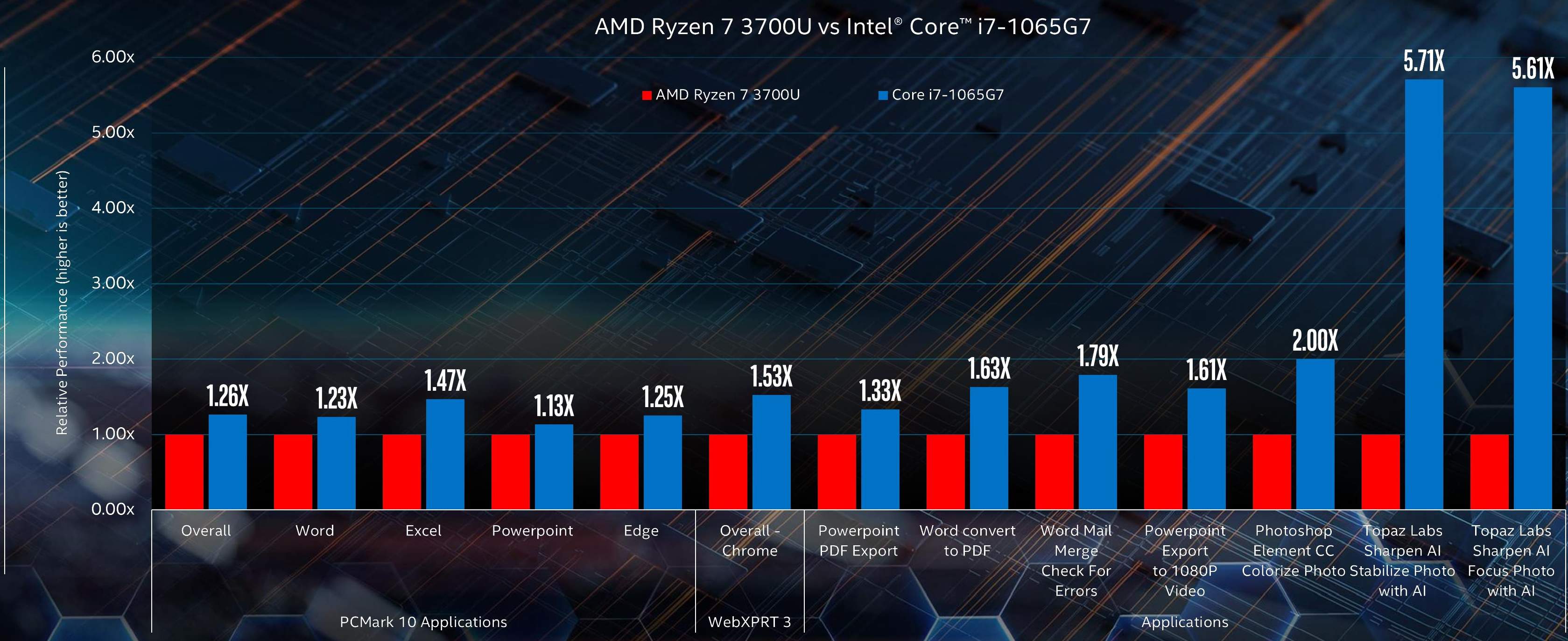Intel can’t decide who is faster: Comet Lake or Ice Lake

In the framework of CES 2020, Intel held several presentations, where it boasted “in real applications” performance of its Core i7-10710U and Core i7-1065G7 processors compared to AMD Ryzen 7 3700U. Of course, tests from the manufacturer itself cannot be objective, and they are out of date the very next day with the announcement of the new Ryzen Mobile 4000 family.
But the fun begins if combine data from different slides – and compare Intel processors between themselves. The results in the diagram above. And they are simply amazing, because the processor of the old Comet Lake family in many tests is faster than the “top” Ice Lake.
Intel deliberately abandoned the “non-representative” synthetic tests such as CineBench, they say, performance in real applications is more important for users.
Whoever shows the tests for presentations – AMD or Intel – usually it is better not to pay attention to the results of these tests. Companies are doing their best to choose such a software configuration in order to more profitably present their own chips.
For example, here is a slide where Intel compares the performance of two comparable systems with an RTX 2060 graphics card. One system is on an R7 3750H processor, the second is an i7-9750H, and a system on an i9-9980HK with an RTX 2080 card is also nearby for comparison. These processors are aimed at the same one the same gaming segment, and the total dominance of Intel processors is striking.
The graph was supposed to demonstrate that AMD should not even think about gaming PCs, where Intel is without competition. Yes, in social networks, the community agreed that the Ryzen Mobile 3000 is not a competitor here, all discussed only the question that Intel tests were immediately out of date, because the very next day AMD announced the new Ryzen Mobile 4000 processors.
But the most interesting is shown on two other slides with the performance of light laptops with 15 W processors. These are the slides.
The first comparison of AMD Ryzen 7 3700U and Core i7-10710U family Comet Lake:
On the second comparison AMD Ryzen 7 3700U and Core i7-1065G7 of Ice Lake family:
It turns out such a strange picture:
| Intel tests: Comet Lake vs Ice Lake | |||
| AMD Ryzen 7 3700U | Intel Comet Core i7-10710U | Intel Ice Core i7-1065G7 | |
| PCMark10 overall | 1.00x | 1.33x | 1.26x |
| PCMark10 Word | 1.00x | 1.36x | 1.23x |
| PCMark10 Excel | 1.00x | 1.61x | 1.47x |
| PCMark10 PowerPoint | 1.00x | 1.16x | 1.13x |
| PCMark10 Edge | 1.00x | 1.24x | 1.25x |
| WebXPRT3 | 1.00x | 1.48x | 1.53x |
| Export PowerPoint PDF | 1.00x | 1.83x | 1.33x |
| Word Convert to PDF | 1.00x | 1.68x | 1.63x |
| Word Mail Merge Error Check | 1.00x | 1,54x | 1.79x |
| PowerPoint Export to 1080p Video | 1.00x | 1.44x | 1.61x |
| PS Element CC Colorize Photo | 1.00x | 2.00x | 2.00x |
Both Intel processors are considered the “10th generation Core” processors, but the “old” Comet Lake is produced using the 14 ++ nm process technology, with 6 cores and Gen 9 graphics, while the “new” Ice Lake is produced in the 10 nm production process with 4 cores, higher IPC (number of instructions per cycle) and Gen 11 graphics.
It would seem that Ice Lake should win in most tests. Moreover, Intel itself positions it in the premium segment as a more expensive CPU, and Core i7-10710U – for the mass market. However, the latter looks very worthy. In fact, he even beats the “fashionable” brother with a score of 6: 4.
According to experts, the i7-10710U could gain an advantage in some tests due to the higher clock speed in turbo mode (4.7 versus 3.9 GHz), while Ice Lake’s newfangled features like AI calculations are very niche modules that little in demand in real life.
In general, these results show that “processor families” are largely a marketing term, and a cheaper processor may be faster than an expensive one. Sometimes rough clock speeds are more important than advanced architecture.







